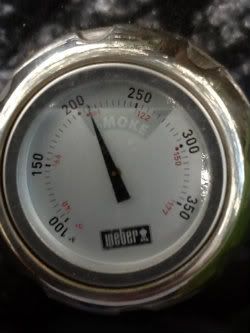Bob Mann
TVWBB Honor Circle
I did a couple of racks of spares tonight.
http://tvwbb.com/eve/forums?a=...001064046#5001064046
My target temp was 275F.
For much of the cook, my stock Weber 22 1/2" WSM dome thermometer read about 50F lower than my ET-732 pit probe at the grate. I tested the Maverick with boiling water, it's calibrated.
Don't trust your dome thermometer.
Weber dome thermometer.

Maverick ET-732.

Bob
http://tvwbb.com/eve/forums?a=...001064046#5001064046
My target temp was 275F.
For much of the cook, my stock Weber 22 1/2" WSM dome thermometer read about 50F lower than my ET-732 pit probe at the grate. I tested the Maverick with boiling water, it's calibrated.
Don't trust your dome thermometer.
Weber dome thermometer.

Maverick ET-732.

Bob




